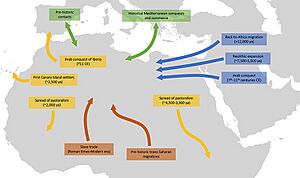Pastoral Neolithic facts for kids
The Pastoral Neolithic was a special time in Africa's past, mainly in Tanzania and Kenya. It happened between about 5,000 and 1,200 years ago. This period marked the start of people producing their own food, raising animals like cattle, sheep, and goats, and using pottery. Before this, people mostly hunted and gathered their food.
Unlike other parts of the world where the Neolithic period brought farming, in East Africa, people mostly became nomadic pastoralists. This means they moved around with their herds of animals. These animals were first tamed outside of East Africa, likely in North Africa. The Pastoral Neolithic shows how people started relying on animals instead of just hunting.
Archaeologists often use the term "Pastoral Neolithic" to describe these early animal-herding times in eastern Africa. In the Sahara Desert, hunter-gatherers started raising animals around 8,000 to 7,000 years ago. As the Sahara became drier, these herders moved into the Nile Valley and then into eastern Africa.
During the Pastoral Neolithic in eastern Africa, two main herding groups spread through southern Kenya and northern Tanzania. These groups, called the Savanna Pastoral Neolithic and the Elmenteitan, lived alongside hunter-gatherers. After the Pastoral Neolithic, about 2,000 years ago, came the Pastoral Iron Age. This was when farming, iron tools, and Bantu speakers spread into the region.

Contents
Where Did It Begin?
The Pastoral Neolithic started after the Later Stone Age, around 5,000 years ago. The first signs of food production in East Africa are found in Kenya and Tanzania. The very first Pastoral Neolithic sites are near Lake Turkana, dating back to about 5,000 years ago.
At first, people in Africa had domestic animals but didn't live exactly like modern herders. Early sites show more bones from wild animals than from tamed ones. These early herding cultures didn't usually have settled farms or use metal. We don't know the exact timeline for how herding fully began in eastern Africa.
Scientists studying animal bones (the faunal record) found that the animals herded during the Pastoral Neolithic were not tamed in East Africa. Instead, they were brought in from elsewhere. There are no fossils of wild cattle, sheep, or goats in East Africa that would suggest they were tamed there. This means common farm animals were not present in places like the Turkana Basin or Serengeti Plains before this period.
Some ancient cave paintings in Mt. Elgon, Kenya, show cattle breeds from northern Africa. These tamed animals likely arrived in northern Africa around 8,000 years ago and reached Eastern Africa by 5,000 years ago. Different types of cattle were brought in at various times throughout the Pastoral Neolithic.
Genetic studies show that some East African people developed the ability to digest milk (called lactase persistence) between 7,000 and 3,000 years ago. This fits with when livestock were introduced. DNA evidence from 2019 suggests that herders moved into Eastern Africa around 5,000 years ago. They had ancestors from both the Near East and Sudan.

How Did People Move?
We don't fully understand how herding reached East Africa during the Pastoral Neolithic. Pottery and stone tools found near Lake Turkana suggest that people from Ethiopia and Sudan traveled south. They moved in small groups, bringing herding with them.
Much evidence points to two big movements of people in eastern Africa. These movements, linked to the spread of Afro-Asiatic and Nilo-Saharan languages, changed how people got their food.
A 2019 study looked at DNA from ancient bones in Kenya and Tanzania. It found that modern people who speak Afro-Asiatic languages are related to groups from the Pastoral Neolithic. These languages are spoken today in North Africa, the Horn of Africa, and the Middle East. The ancient bones showed the most similarity to Cushitic-speaking people. These early herders from the northeast were a mix of people related to modern Nilo-Saharan speakers (like the Dinka) and people from northern Africa or the Levant. These mixed groups then moved further into eastern Africa.
A 2022 study found that ancient people from Nubia (around 4,000 years ago) were genetically very similar to those of the Pastoral Neolithic. This suggests that the Pastoral Neolithic might have started with a fast movement of people from the Nile Valley. It might not have involved much mixing with the local hunter-gatherers, as was thought before.
In Southern Africa, farming plants also started much later than taming cattle and other animals. This was also true in places like India and Peru. Some researchers believe African cattle were tamed around 10,000 years ago, but plant farming came after 4,000 years ago. They think that in Africa, having more food from farming wasn't as important as being able to move animals to find food during dry times. Studies also show that herding activities helped keep grasslands rich. This is because the rich grass attracted both wild and herded animals, keeping the cycle going.
What Was Life Like?
Neolithic herders used different ways to get food, like fishing and herding. They also used stone tools, made ceramics (pottery), and had special ways of burial.
How They Herded
The change from hunting and gathering to herding happened slowly, over thousands of years. The Pastoral Neolithic in East Africa is one of the few times in history where herding became important long before farming.
The big shift from mostly hunting to mostly herding probably happened around 3,000 years ago. Before 3,000 years ago, there are few bones of tamed animals at sites. For example, at a rock shelter in central Kenya called Enkapune Ya Muto, most animal bones were from wild animals. But there were a few teeth from goats or sheep, dating to about 4,400 years ago.
It took a long time for people to fully adopt domestic animals after they were first introduced. This might be because there was a cultural difference between the new people and the local groups. Also, weather evidence from Lake Naivasha, Kenya, suggests that rain patterns might not have been good for dairy farming until around 3,000 years ago.
After 3,000 years ago, most animal bones found at Pastoral Neolithic sites were from tamed animals. By this time, many communities were only keeping and herding livestock.
Stone Tools They Used
Quick facts for kids Luxmanda |
|
|---|---|
| Lua error in Module:Location_map at line 420: attempt to index field 'wikibase' (a nil value). | |
| Location | Tanzania |
Studying the stone tools used by Neolithic herders helps us understand their technology.
Famous archaeologists Louis Leakey and Mary Leakey studied "Stone Bowl cultures." They found a lot of evidence about how people got food during the Pastoral Neolithic.
The archaeological site at Luxmanda, Tanzania, was first used around 3,000 years ago. This makes it the southernmost Pastoral Neolithic site found so far in Africa. The size of the stone tools at Luxmanda suggests that these communities might not have moved around as much as thought. Stones were used for grinding plants and for pounding bones to get marrow and fat. These tools from Luxmanda challenge older ideas about how people traveled and got food during this time.
Evidence from the Lake Turkana region shows that two types of pottery, Nderit and Ileret pottery, appeared between 4,500 and 4,200 years ago. These unique decorated pots are linked to the taming of sheep and cattle in the area.
Burial Customs

Digging up cemeteries and burial sites from the Pastoral Neolithic gives us clues about their traditions and how their societies were organized.
The Lothagam North Pillar Site is a large community cemetery near Lake Turkana, where the earliest Pastoral Neolithic sites are found. This site has a big stone structure that likely holds at least 580 people. The people buried there were of different ages, genders, and social groups. This site supports the idea that communities were moving around a lot during the Pastoral Neolithic.
When Did It End?
The Pastoral Neolithic ended around 1,200 years ago, when people started using metal, especially iron. The iron-using herders of the Early Iron Age were descendants of Pastoral Neolithic groups, people who moved in from Northern Africa, and other populations. The Pastoral Iron Age followed the Pastoral Neolithic. This period saw new groups of northern Nilotic peoples arrive, and later, the Iron Age migration of Bantu farmers.


